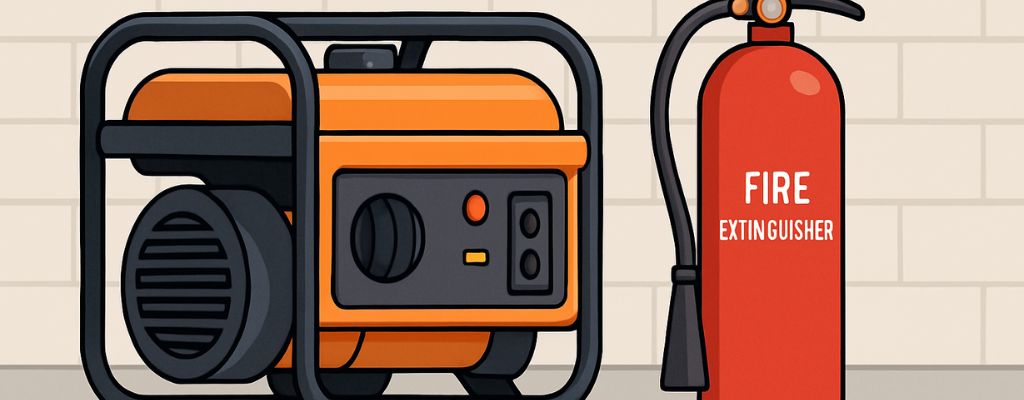
What Kind of Fire Extinguisher Should I Keep Near a Generator?
Generators are lifesavers—until they try to barbecue your shed. So, what kind of fire extinguisher should you keep near a generator? A Class ABC dry chemical one. It tackles fuel, electrical, and everyday fires like a pro. Stick around to learn why size, placement, and Australian safety standards actually matter.

Understanding Fire Risks and Extinguisher Basics for Your Generator
Generators are great when the power’s out, but let’s not pretend they’re harmless. Between flammable fuel, hot engines, and messy cables, things can go south fast.
The key to staying safe? Know what kind of fires you're up against—and have the right extinguisher nearby to deal with them.
What are the 4 Types of Fire Extinguishers? General Classes for Your Generator Safety
Fire extinguishers are sorted by what they're meant to fight. Here's how they stack up when it comes to generator risks.
Class A: Ordinary Combustibles
Think leaves, cardboard boxes, or any stray junk lying around your shed. If it catches fire from generator heat or a spark, you’ll need a Class A extinguisher to smother it.
Class B: Flammable Liquids and Gases
Petrol, diesel, propane—basically everything a generator drinks. These fires are fast and furious, so having Class B protection is non-negotiable.
Class C: Electrical Equipment
Wires, plugs, control panels. One short circuit and you’ve got a fire hazard on your hands. Class C is made for exactly this kind of chaos.
Class D: Combustible Metals
Unless you're running a workshop with magnesium or titanium, Class D won’t matter. It's more of an industrial concern than something you'd deal with at home.
What are the 5 Types of Fire Extinguishers? A More Detailed Look for Your Generator Needs
Let’s add one more class to the mix—just to round things out.
Adding Class K: Kitchen Fires (Less common for generator but good for completeness)
Class K handles cooking oil and fat fires. It’s mostly used in restaurants, but hey, if your generator’s running next to a food truck, it might come in handy.
What are the 5 Types of Fire Extinguishers and Their Uses? Applying Knowledge to Your Generator
-
Class A: For burning wood, leaves, or rubbish.
-
Class B: For fuel fires around your generator.
-
Class C: For dodgy electrical fires.
-
Class D: For rare metal-related fires.
-
Class K: If your generator’s near a deep fryer (unlikely, but worth noting).
What are the 7 Types of Fire Extinguishers? Comprehensive Classification for Your Generator Environment
If you’re in a specialised setting, the fire extinguisher list can grow even longer.
Delving Deeper into Specialised Extinguisher Types for Complex Generator Scenarios
Foam, wet chemical, clean agents—you name it. These are used in high-risk environments like data centres, labs, and emergency rooms. They’re not your average backyard solution, but if your generator setup is more complex, you might need to consider them.

Choosing the Right Fire Extinguisher for Your Generator’s Potential Hazards
The right extinguisher isn’t a one-size-fits-all. It depends on what fuels your generator and what might go wrong.
Type B Fire Extinguisher: Essential for Fuel-Related Generator Fires
Why Class B is Critical for Petrol, Diesel, or Propane Fires Around Your Generator
If your generator runs on fuel—and let’s be honest, most do—it’s a walking Class B fire risk. Even a small leak can ignite in seconds. That’s why you always want to keep Class B protection nearby.
Best Agents for Suppressing Flammable Liquid Fires Near Your Generator
Dry chemical agents are the top pick. They smother flames quickly and work across Classes A, B, and C. Foam can help too, but it doesn’t cover as much ground.
Which Type of Fire Extinguisher is Used for Fire on Electrical Equipment Near Your Generator?
The Importance of Non-Conductive Agents for Electrical Fires Involving Your Generator
Water and electricity don’t mix—unless you like living dangerously. For any electrical fire, make sure the extinguisher you use won’t conduct current.
Carbon Dioxide (CO2) Extinguishers: An Ideal Choice for Your Generator’s Electrical Components
CO₂ is clean, effective, and won’t leave a powdery mess behind. It's perfect for generators with sensitive electronics. Just don’t use it in windy weather—it might blow away before it hits the fire.
Fire Extinguisher for Diesel Generator: Specific Considerations
Handling Diesel Fuel Fires with the Right Class B/C Extinguisher for Your Generator
Diesel isn’t as volatile as petrol, but once it ignites, it burns hot and heavy. That’s where a Class B or dual-rated B/C extinguisher earns its keep.
Ensuring Your Diesel Generator’s Electrical Systems are Protected
Don’t forget the wiring. Diesel engines still come with electrical bits that need Class C cover. One extinguisher that handles both is your best bet.

Placement, Maintenance, and Prevention for Your Generator’s Fire Safety
Even the best extinguisher won’t help if you can’t get to it—or if it’s dead when you need it.
Strategic Placement of Your CO2 Fire Extinguisher Near Your Generator
Accessibility: Ensuring Your Extinguisher is Within Reach of Your Generator
Mount it somewhere obvious. Not behind a locked cabinet or under a pile of tools. You want it close enough that you can grab it without thinking twice.
Environmental Considerations for Storing Your Generator’s Fire Extinguisher
Australia’s heat and weather can mess with extinguisher pressure. Keep it shaded, dry, and out of direct sun. If it’s outdoors, invest in a proper cabinet or weatherproof cover.
General Fire Safety Practices for Your Generator
Proper Ventilation and Clearances to Reduce Fire Risk from Your Generator
Always run your generator in open air. Enclosed spaces trap heat and fumes—and that’s a recipe for fire. Keep it away from walls, fences, or anything flammable.
Regular Maintenance of Your Generator to Prevent Malfunctions Leading to Fire
Make inspections a habit. Check for leaks, frayed cables, or dust build-up. A quick once-over every few uses can save you from a real headache later.
Conclusion: Protecting Your Investment and Ensuring Safety Around Your Generator
Generators are there to save the day—not cause a disaster. Keeping a Class ABC dry chemical extinguisher nearby is the smartest way to stay prepared.
Look for one that meets Australian Standards AS/NZS 1841 and 2444.
Mount it properly. Check it monthly. Replace it if the pressure’s off.
And always, always know how to use it.
Because when things go wrong, every second counts.


